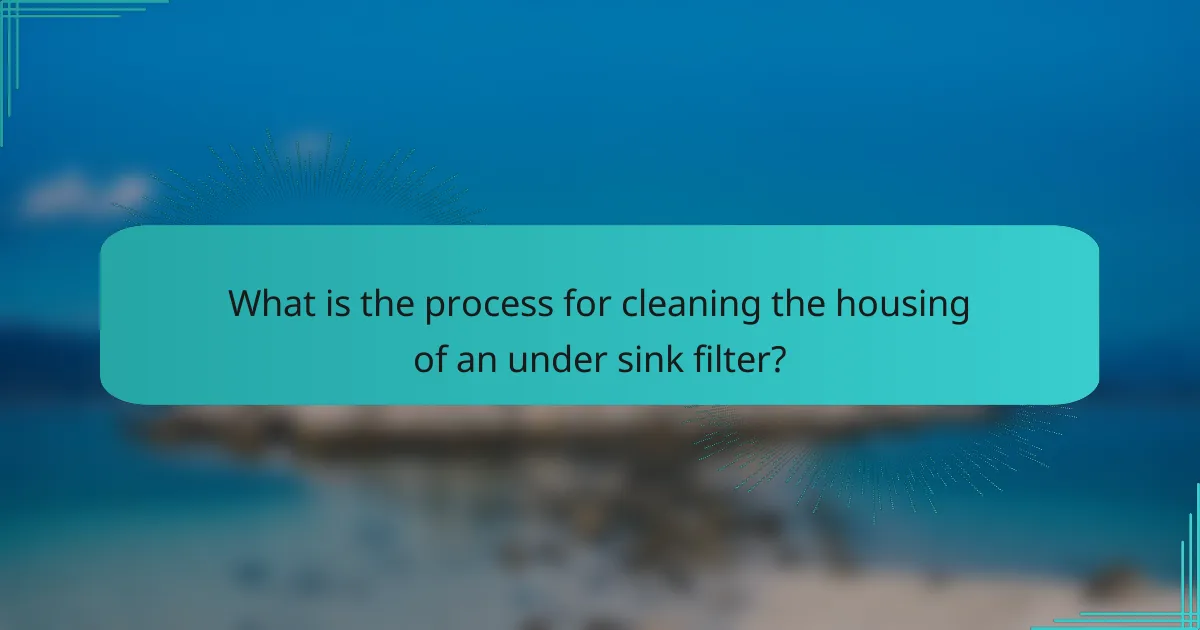Maintaining your under sink filter is crucial for ensuring clean and safe drinking water. Regularly checking for leaks, replacing the filter, and cleaning the housing are essential steps that help prolong the life of your system and enhance its performance. By following these simple maintenance practices, you can prevent issues and ensure your filter operates efficiently.

How to check for leaks in under sink filters?
To check for leaks in under sink filters, start with a thorough visual inspection and consider using tools like a moisture meter. Regular checks can prevent water damage and ensure the filter operates efficiently.
Visual inspection of connections
Begin by examining all visible connections, including the inlet and outlet hoses. Look for any signs of water pooling, corrosion, or mineral buildup around joints and fittings.
Pay special attention to the areas where the filter connects to the plumbing. Tighten any loose connections, as they are common sources of leaks.
Using a moisture meter
A moisture meter can help detect hidden leaks that are not visible to the naked eye. Place the meter near the filter and along the pipes to check for elevated moisture levels.
When using a moisture meter, look for readings above 15% moisture content, which could indicate a leak. Regular monitoring can help catch issues early.
Checking water pressure
High water pressure can lead to leaks in under sink filters. Use a pressure gauge to measure the water pressure in your home, ideally aiming for a range of 40-60 psi.
If the pressure exceeds this range, consider installing a pressure regulator to prevent strain on the filter and connections, which can lead to leaks over time.

When should you replace your under sink filter?
You should replace your under sink filter every 6 to 12 months to ensure optimal water quality and flow. Regular replacement helps prevent contaminants from building up and maintains the filter’s effectiveness.
Every 6 to 12 months
Most under sink filters have a recommended replacement schedule of every 6 to 12 months, depending on usage and water quality. If your household consumes a lot of water or if your water supply has higher levels of contaminants, you may need to replace the filter more frequently.
Check the manufacturer’s guidelines for specific recommendations, as some filters may have indicators that signal when it’s time for a replacement. Keeping a calendar reminder can help you stay on track with replacements.
Signs of reduced water flow
If you notice a significant decrease in water flow from your under sink filter, it may be time for a replacement. Reduced flow can indicate that the filter is clogged with sediment or contaminants, which can hinder its performance.
To assess the flow rate, compare it to the normal output when the filter was new. If the water flow is noticeably slower, consider replacing the filter to restore optimal performance.
Unusual taste or odor
Experiencing an unusual taste or odor in your filtered water is a clear sign that the filter may need replacing. Over time, filters can become saturated with contaminants, leading to unpleasant flavors or smells.
If your water starts to taste metallic, earthy, or has a chlorine-like odor, it’s best to replace the filter. Regular checks can help you maintain water quality and ensure that your drinking water remains safe and pleasant.

What is the process for cleaning the housing of an under sink filter?
Cleaning the housing of an under sink filter is essential for maintaining water quality and ensuring the filter operates efficiently. The process involves several straightforward steps, including turning off the water supply, removing the filter cartridge, and using mild soap and water for cleaning.
Turn off the water supply
Before starting the cleaning process, ensure that the water supply to the under sink filter is turned off. This prevents any accidental leaks or water flow while you are working on the unit. Locate the shut-off valve, which is typically found near the water line leading to the filter, and turn it clockwise to close it.
After shutting off the water, it’s advisable to open the faucet connected to the filter to relieve any pressure in the system. This step helps avoid spills when you remove the filter cartridge later.
Remove the filter cartridge
Once the water supply is off, proceed to remove the filter cartridge from the housing. Depending on the model, this may involve twisting or pulling the cartridge out. Always refer to the manufacturer’s instructions for specific removal steps to avoid damaging the filter or housing.
Inspect the cartridge for any signs of wear or damage. If it appears worn, consider replacing it with a new one to ensure optimal filtration performance. Keep the cartridge in a safe place while you clean the housing.
Use mild soap and water
To clean the housing, use a mixture of mild soap and warm water. Avoid harsh chemicals or abrasive cleaners, as these can damage the housing material. Dampen a soft cloth or sponge with the soapy water and gently wipe down the interior and exterior surfaces of the housing.
After cleaning, rinse the housing thoroughly with clean water to remove any soap residue. Allow it to air dry completely before reassembling the filter cartridge and turning the water supply back on. Regular cleaning helps maintain the efficiency of your under sink filter and prolongs its lifespan.

What are the best under sink filter brands in the UK?
Some of the top under sink filter brands in the UK include Brita, Waterdrop, and APEC. These brands are known for their reliability, filtration efficiency, and user-friendly designs, making them popular choices for households seeking clean drinking water.
Brita
Brita is a well-established brand in the water filtration market, known for its effective filtration systems. Their under sink filters typically use activated carbon and ion exchange technology to reduce contaminants such as chlorine, lead, and sediment.
When considering Brita, look for models that are easy to install and maintain. Regular filter replacements are essential, usually every six months, to ensure optimal performance.
Waterdrop
Waterdrop offers innovative under sink filters that utilize advanced filtration technologies, including reverse osmosis. Their systems are designed to remove a wide range of impurities, providing high-quality drinking water.
One advantage of Waterdrop filters is their compact design, which saves space under the sink. Be mindful of the filter replacement schedule, typically every 12 months, to maintain water quality.
APEC
APEC is recognized for its robust under sink filtration systems that often feature multi-stage filtration processes. These systems effectively eliminate harmful substances while retaining beneficial minerals.
APEC filters generally require less frequent replacements, around every two years, making them a cost-effective option. Ensure proper installation for optimal performance and consider professional help if needed.

What are the common issues with under sink filters?
Common issues with under sink filters include clogged filters and leakage problems. Addressing these issues promptly can ensure the filter operates efficiently and prolong its lifespan.
Clogged filters
Clogged filters occur when contaminants build up, restricting water flow and reducing filtration efficiency. Regularly checking and replacing filters, typically every six months to a year, can help prevent this issue.
Signs of a clogged filter include reduced water pressure and unusual tastes or odors in the water. To maintain optimal performance, consider installing a pressure gauge to monitor changes in water flow.
Leakage problems
Leakage problems can arise from improper installation, worn-out seals, or damaged hoses. Regularly inspect the connections and seals for any signs of wear or damage to prevent leaks.
If you notice water pooling under the sink, check the filter housing and connections. Tightening fittings or replacing worn components can often resolve minor leaks. For persistent issues, consulting a professional may be necessary to ensure proper repair.


